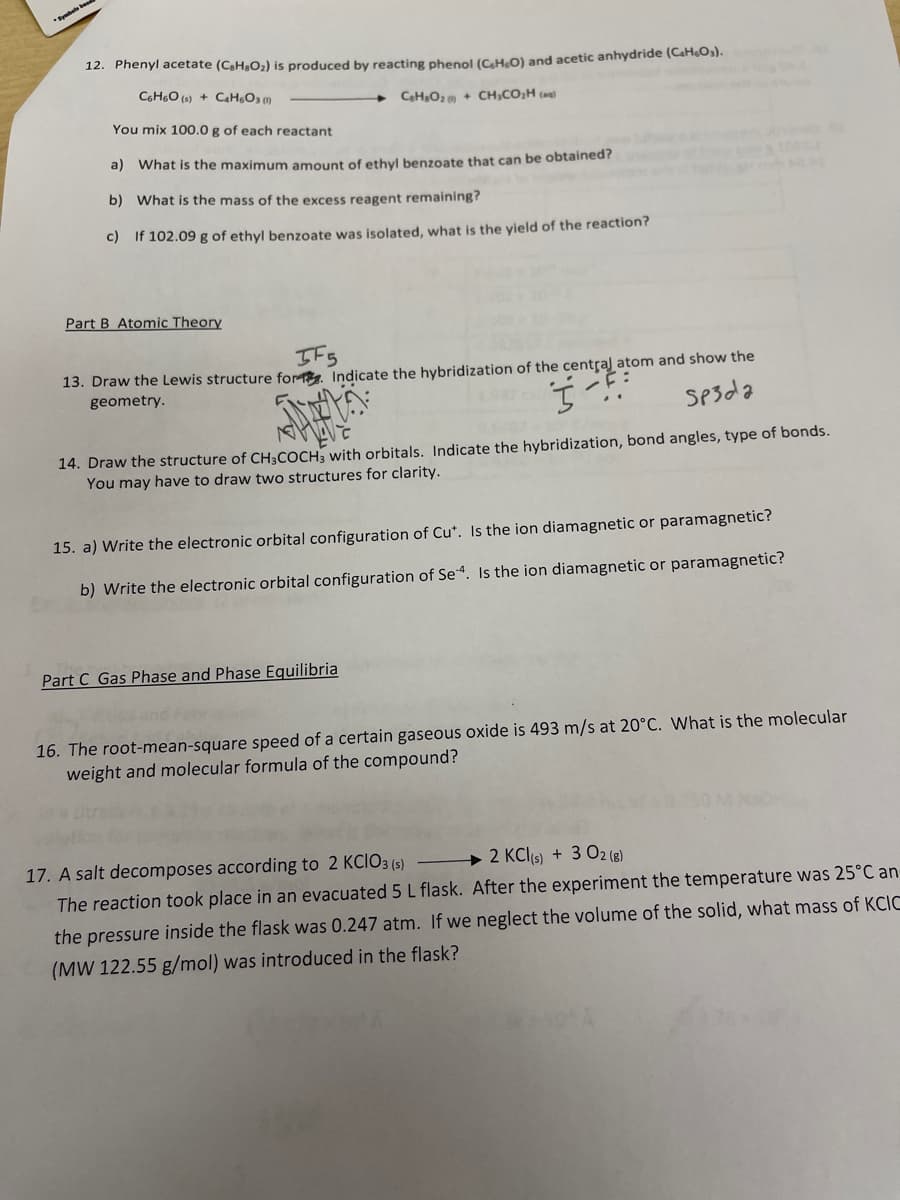12. Phenyl acetate (CaHO,) is produced by reacting phenol (CH.O) and acetic anhydride (CaH.Os). CHO (s) + CaH,O3 m + CaH,Ozm + CH,CO,H ( - You mix 100.0 g of each reactant a) What is the maximum amount of ethyl benzoate that can be obtained? b) What is the mass of the excess reagent remaining? c) If 102.09 g of ethyl benzoate was isolated, what is the yield of the reaction?
12. Phenyl acetate (CaHO,) is produced by reacting phenol (CH.O) and acetic anhydride (CaH.Os). CHO (s) + CaH,O3 m + CaH,Ozm + CH,CO,H ( - You mix 100.0 g of each reactant a) What is the maximum amount of ethyl benzoate that can be obtained? b) What is the mass of the excess reagent remaining? c) If 102.09 g of ethyl benzoate was isolated, what is the yield of the reaction?
Chemistry for Engineering Students
3rd Edition
ISBN:9781285199023
Author:Lawrence S. Brown, Tom Holme
Publisher:Lawrence S. Brown, Tom Holme
Chapter4: Stoichiometry
Section: Chapter Questions
Problem 4.77PAE: The pictures below show a molecular-scale view of a chemical reaction between H2 and CO to produce...
Related questions
Question
12

Transcribed Image Text:12. Phenyl acetate (CH,o,) is produced by reacting phenol (CH.0) and acetic anhydride (CaHOs).
CHO (s) + C,H¢O3 1)
CaH,Oz m + CH,CO;H (nal
You mix 100.0 g of each reactant
a) What is the maximum amount of ethyl benzoate that can be obtained?
b) What is the mass of the excess reagent remaining?
c) If 102.09 g of ethyl benzoate was isolated, what is the yield of the reaction?
Part B Atomic Theory
IFS
13. Draw the Lewis structure for. Indicate the hybridization of the central atom and show the
geometry.
SP3da
14. Draw the structure of CH3COCH; with orbitals. Indicate the hybridization, bond angles, type of bonds.
You may have to draw two structures for clarity.
15. a) Write the electronic orbital configuration of Cu*. Is the ion diamagnetic or paramagnetic?
b) Write the electronic orbital configuration of Se4. Is the ion diamagnetic or paramagnetic?
Part C Gas Phase and Phase Equilibria
16. The root-mean-square speed of a certain gaseous oxide is 493 m/s at 20°C. What is the molecular
weight and molecular formula of the compound?
17. A salt decomposes according to 2 KCIO3 (5)
+ 2 KCIS) + 3 02 (8)
The reaction took place in an evacuated 5 L flask. After the experiment the temperature was 25°C an
the pressure inside the flask was 0.247 atm. If we neglect the volume of the solid, what mass of KCIC
(MW 122.55 g/mol) was introduced in the flask?
Expert Solution
This question has been solved!
Explore an expertly crafted, step-by-step solution for a thorough understanding of key concepts.
Step by step
Solved in 2 steps

Knowledge Booster
Learn more about
Need a deep-dive on the concept behind this application? Look no further. Learn more about this topic, chemistry and related others by exploring similar questions and additional content below.Recommended textbooks for you

Chemistry for Engineering Students
Chemistry
ISBN:
9781285199023
Author:
Lawrence S. Brown, Tom Holme
Publisher:
Cengage Learning

Introductory Chemistry: A Foundation
Chemistry
ISBN:
9781337399425
Author:
Steven S. Zumdahl, Donald J. DeCoste
Publisher:
Cengage Learning

Chemistry for Engineering Students
Chemistry
ISBN:
9781337398909
Author:
Lawrence S. Brown, Tom Holme
Publisher:
Cengage Learning

Chemistry for Engineering Students
Chemistry
ISBN:
9781285199023
Author:
Lawrence S. Brown, Tom Holme
Publisher:
Cengage Learning

Introductory Chemistry: A Foundation
Chemistry
ISBN:
9781337399425
Author:
Steven S. Zumdahl, Donald J. DeCoste
Publisher:
Cengage Learning

Chemistry for Engineering Students
Chemistry
ISBN:
9781337398909
Author:
Lawrence S. Brown, Tom Holme
Publisher:
Cengage Learning

Chemistry: Principles and Practice
Chemistry
ISBN:
9780534420123
Author:
Daniel L. Reger, Scott R. Goode, David W. Ball, Edward Mercer
Publisher:
Cengage Learning


Chemistry
Chemistry
ISBN:
9781305957404
Author:
Steven S. Zumdahl, Susan A. Zumdahl, Donald J. DeCoste
Publisher:
Cengage Learning